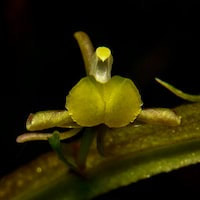WOR12 - Women's Oriental 12 - Carbon poppy
|
Native Singaporean Orchid notes: Cattleya Aloha Case (Dark Purple Form)
Cattleya Aloha Case (Dark Purple Form) is a captivating orchid chosen for the Oriental 12 (Women) team-building perfume workshop. Its deep red-purple flowers stand out with their striking color and large size relative to the plant. Known for its exceptional fragrance, this orchid adds a sensory experience to the workshop, inspiring participants to explore and blend scents creatively. By featuring Cattleya Aloha Case, the workshop cultivates an atmosphere of beauty, inspiration, and collaborative creativity, making it a memorable event for everyone involved.
|
Therapeutic Orchid notes:
|
Bromheadia finlaysoniana
Bromheadia finlaysoniana, known locally as Seraman in Kelabit, Wi buntak in Iban, and Busak paya in Malay, is an orchid species found in Malaysia. It belongs to a group of 17 species ranging from Sri Lanka across Southeast Asia to Australia. While species like B. brevifolia and B. ruprestris thrive in Malaysian highlands, B. finlaysoniana prefers lowland regions. Its flowering pattern is unique, with abundant blooms appearing unpredictably due to the growth behavior of its buds. In Malaysian herbal medicine, B. finlaysoniana has been used to treat rheumatism with root decoctions in Malacca, alleviate asthma with flower stalks chewed in Peninsular Malaysia, and ease body aches in Sarawak, showcasing its versatility and cultural importance. These traditional uses highlight the orchid's role in local healing practices and underscore the importance of preserving such knowledge and practices for future generations. |
|
Dendrobium transparens Wall ex Lindl.
Dendrobium transparens Wall ex Lindl., known as Parajivi and Thuur in Nepali, is an orchid species found from the eastern Himalaya to regions like Yunnan and Myanmar. In Nepal's traditional herbal practices, it is valued for treating fractures and dislocated bones, believed to promote bone healing and alleviate bone injuries. While Dendrobium catenatum was historically prominent in Traditional Chinese Medicine, other species like Dendrobium transparens are recognized for their medicinal potential. These orchids underscore the deep botanical knowledge and cultural significance in traditional healing, supporting community health and preserving cultural heritage for future generations. |
|
Habenaria Willd.
Habenaria Willd. is a genus of orchids known for its cultural significance across regions. In Chinese, it's called Yufeng hua, meaning phoenix/heron flower, while in Japanese, it's Mizu Tombo. In Sanskrit, it's known as Riddhi. These orchids have a unique life cycle, thriving in areas with distinct wet and dry seasons. They require a dormant phase to flower properly and survive. When the rainy season begins, they send out aerial shoots that grow rapidly during heavy rainfall, eventually producing flowers. After the rains, the aerial parts die off, leaving underground tubers until the next rainy season. This adaptation helps them endure specific climatic conditions. The name "Habenaria" derives from Latin, meaning bridle, whip, strap, or veins, reflecting the thread-like fringe on some species' lips. These orchids are admired for their resilience and beauty, capturing attention in both cultural and scientific communities for their ecological significance and stunning flowers. |
|
Liparis rheedii Lindl.
Liparis rheedii Lindl., called Simil in India, is a unique plant with closely packed pseudobulbs. Its appearance, from deep purple in shade to green in sunlight, adds to its allure. Found from southern India to New Guinea, it thrives in diverse mountain forests. In Karnataka, it's used in traditional medicine as a tonic and is part of the Ayurvedic Ashtavarga. In Orissa, its root treats cholera when boiled and mixed with honey. These uses highlight its cultural and medicinal importance, preserving traditional healing wisdom and botanical heritage. |
|
Paphiopediulun concolor (Lindl. ex Bateman) Pfitzer
Paphiopedilum concolor (Lindl. ex Bateman) Pfitzer, known as Tongseduo Lan (uniform color pouch orchid) in Chinese, is valued in Traditional Chinese Medicine (TCM) for its medicinal properties. Found in regions like Guangxi and Yunnan, it thrives on limestone. TCM categorizes it as "hot and neutral," using the whole plant to treat coughs, asthma, and pain, and for conditions like tuberculosis and arthritis. Combined with other herbs, it enhances efficacy. Traditional preparations include pounding the plant for treating trauma, adding alcohol for sores, and mixing with wine for snake bites. These uses underscore its cultural and medicinal significance, preserving ancient healing traditions and botanical heritage. |
|
Papilionanthe hookeriana (Rchb.f.) Schltr. Syn Vanda hookeriana
Papilionanthe hookeriana (Rchb.f.) Schltr., known as Vanda hookeriana, is an orchid with diverse names across regions. In Malaysia, it's called Kinta weed and pokok tulang (bone plant), while in Indonesia, it's Anggerik pensil (pencil orchid) or Potloodorchidee in Dutch. This orchid thrives in mangrove swamps of Kinta Valley and similar habitats in Southeast Asia. In northern Peninsular Malaysia, a paste made from Papilionanthe hookeriana is used traditionally to ease joint pain, showcasing its medicinal potential. These uses highlight its cultural importance, linking local communities to their natural heritage and sustaining traditional knowledge for future generations. |
Other scent note
Scentopia Library Reference ingredient
Tobacco of the green kind - Check details at Scentopia's scent library
Download the guided mediation that works best with this Orchid fragrance oil
| women_oriental_essential_oil_orchi_00012.mp3 | |
| File Size: | 42798 kb |
| File Type: | mp3 |






